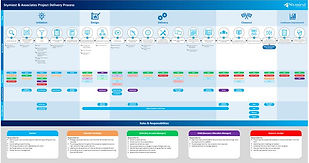
Process Documentation
What we offer
We take a flexible approach to process documentation - whether you need a few processes mapped for an upcoming RFP or a full-scale documentation structure that governs your entire operation.




Process Storyboards
A concise, one-page high level map that provides a bird's-eye view of your company's / department's operations.
SOPs & Work Instructions
We produce clear, structured documents that define the exact steps to execute tasks effectively.

Process Maps
A visual representation that outlines the steps, interactions and flow of a specific workflow or business process.
Other Training Collateral
Engaging multimedia content tailored to educate and upskill employees on tools, methodologies and best practices.
Benefits of Process Documentation
Unclear or outdated processes lead to inefficiencies, confusion and inconsistent execution. Whether you need to document a few key processes for a specific initiative or build a comprehensive framework for process governance, we help structure and visualize workflows in a way that makes them actionable and easy to use.
Training & Onboarding
Scalability
Improved Communication
Clarity & Consitency
Wondering where to start with your company's process documentation? Introducing the Process Storyboard: A concise, one-page process map that provides a bird's-eye view of your company's operations. It's a visual guide that simplifies complex workflows, enhancing transparency and fostering clear understanding across teams.
By outlining core activities and interactions, the Process Storyboard facilitates streamlined communication and the identification of pain point areas for optimization within your business operations.
Process Storyboards




We produce clear, structured documents that define the exact steps to execute tasks effectively in your operation. SOPs provide a consistent framework for operations, ensuring that every team member follows established best practices. Work Instructions offer detailed guidance on specific tasks, enhancing efficiency and reducing errors.
These documents collectively streamline processes, expedite training, and maintain operational consistency within your organization.
SOPs & Work Instructions
Process mapping is a dynamic technique that visually illustrates the flow of a process from start to finish. It employs symbols and shapes to represent different stages, tasks, decisions, and interactions within the process. This visual representation provides a comprehensive and intuitive overview of how various elements fit together. The primary advantage of process mapping is its ability to enhance transparency and clarity. It enables teams to identify bottlenecks, redundancies, and areas for optimization within a process.
By identifying these inefficiencies, organizations can improve operational efficiency, reduce costs and ensure that tasks are carried out in the most effective sequence.
Process Maps


We produce Training Collateral that serves as an invaluable resource for multiple use cases. This includes engaging multimedia content - such as videos, infographics, interactive guides, and e-learning modules - tailored to educate and upskill employees.
Training Collateral complements process documentation by bringing knowledge to life and reinforcing operational excellence across teams.
Other Training Collateral
Case study - WorkDay Implementation

X
Overview
A leading North American distributor was facing an imminent deadline to implement a new HR management platform, Workday. They lacked future state process maps and had gaps in knowledge of roles and responsibilities with respect to the new system.
Stymiest and Associates documented their future state processes by:
Impacts
Interviewing business and application specialists
Conducting process walkthroughs in Workday
Reviewing processes with a broader team of business managers
Socializing the processes with SME's in an interactive workshop
Created clarity around core application processes
Established roles & responsibilities for new processes
Readied the business for
go-live
.png)
.png)

